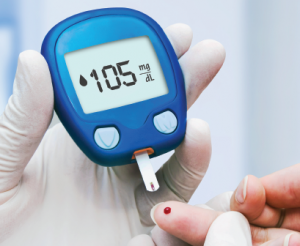
Rheumatologists need to contact the patient’s endocrinologist or primary care physician before starting glucocorticoids.
Piotr Adamowicz / shutterstock.com
In your daily contact with rheumatology patients, you likely come across several who have type 1 or 2 diabetes. Are you doing all you can to maximize their treatment?
Most physicians know about the damaging health effects of uncontrolled diabetes. From vision loss to kidney failure to nerve damage, those with diabetes require regular vigilance to minimize further health issues.
Because type 1 diabetes and many rheumatological health issues are autoimmune conditions, it’s not uncommon for patients with rheumatoid arthritis (RA), psoriatic arthritis or ankylosing spondylitis to have co-existing diabetes. Endocrinologist Joshua Miller, MD, medical director of diabetes care for Stony Brook Medicine in Stony Brook, N.Y., always asks patients with diabetes about a family history of autoimmune disease, because this may lead to a higher risk for concurrent autoimmune problems, including those within rheumatology.
The development of type 2 diabetes often increases with age, as well as obesity or a family history of diabetes. The number of Americans with type 2 diabetes is rapidly growing (see sidebar, right).
Endocrinologist Sofía E. Vasquez, MD, Tenet Florida Physician Services, Hialeah, Fla., estimates 25% of her patients have both diabetes and a rheumatological condition, particularly osteoarthritis or RA.
Endocrinologist Brenda M. Acosta, MD, Tenet Florida Physician Services, Doral, Fla., puts the estimate for her practice closer to 30%; conditions she sees most often include lupus, RA, fibromyalgia, osteoarthritis and gout.
A study published this year that focused on diabetes among those with RA found a 20% prevalence.1 Older patients, males, those with a higher body mass index and those in a lower socioeconomic level had a greater chance of having diabetes. Cardiovascular disease, depression and renal failure also were more common in patients with both diseases.
Patients with both lupus and diabetes may be less commonly seen; some studies point to the protective role of hydroxychloroquine against diabetes mellitus, says rheumatologist Anca D. Askanase, MD, MPH, clinical director and founder of the Columbia University Lupus Center and associate professor of medicine, Division of Rheumatology, Columbia University Medical Center, New York.
To improve care for patients with these concurrent and chronic diseases, The Rheumatologist asked several endocrinologists and rheumatologists for their advice. Here are their pearls.
1. Communicate before you start a patient on steroids.
On a weekly basis, Dr. Miller has patients with concurrent rheumatological disease or chronic obstructive pulmonary disease who get treated with a high dose of steroids. The patients’ blood sugars skyrocket between 300 and 600, and won’t budge. He sends them to the emergency department to get their blood sugar lowered. “It’s not an insignificant challenge that we face,” he says.
This is why Dr. Miller urges rheumatologists to get in touch with the patient’s endocrinologist or primary care physician (PCP) before starting glucocorticoids—and to let the patient know the importance of this communication and collaboration. “I’ll tell patients to give me a call, and we can devise changes to their diabetes regimen that prevent their blood sugar from going up too much,” Dr. Miller says. Some patients and doctors are good about making that call; others are not.
The use of glucocorticoids can increase the need for daily insulin by 20–50%, Dr. Miller says. He will increase a patient’s insulin use accordingly when the patient is using glucocorticoids.
The kind of insulin used may change during treatment with glucocorticoids, says endocrinologist Elizabeth S. Halprin, MD, clinical director, Adult Diabetes, Joslin Diabetes Center, Boston. She sometimes prescribes an older insulin, called NPH, when patients use prednisone every morning.
Even with these measures, it can be hard to maintain blood sugar control, and Dr. Miller cautions patients to expect reasonable, but not perfect, blood sugar numbers when they are using steroids.
As an extra safety measure, do your best to communicate any major medication change with a patient’s diabetes care provider, Dr. Vasquez advises. “It is essential for an endocrinologist to know the specific therapy, drug type and dose that a patient with a rheumatological disease is using to tailor their diabetic treatment appropriately,” she says.
2. Push physical activity.
“Lifestyle modifications, including weight loss and exercise, are important for both diabetes and arthritis,” says rheumatologist Petros Efthimiou, MD, FACR, clinical professor of medicine, NYU Langone Health, New York. “Many times, the rheumatologist will manage the concomitant arthritis so the patient can exercise more, lose weight, and decrease cardiovascular risk factors.”
When Dr. Askanase treats a patient with both diabetes and a rheumatological disease, she emphasizes weight loss, exercise and tight diabetes control.
Of course, some patients may have limitations on how, or how often, they can move. Dr. Halprin works closely with exercise physiologists to tailor physical activity for each patient based on the individual’s joint issues. Still, everyone can benefit from some sort of movement.
“A very small increase will help, such as chair exercises, bands or a 10-minute walk a day,” Dr. Halprin says. “There’s always some movement that can be done.”
Water exercises, low-impact cardio and physical therapy also may be recommended for patients with diabetes and functional limitations from joint pain, Dr. Vasquez says.
3. Encourage education.
Physical therapist and diabetes educator Karen Kemmis, PT, DPT, CDE, FAADE, SUNY Upstate Medical University, Syracuse, New York, encourages those with a rheumatological disease and diabetes to see a diabetes educator for better education and support. A rheumatologist can suggest such a visit to patients, even if they need to follow up with their PCP or endocrinologist for more information or a referral. When a patient sees a diabetes educator, self-care behaviors, such as healthy eating, being active, taking medication and healthy coping are covered, Dr. Kemmis says. “A complete evaluation would be performed, followed by an individualized plan that would take the rheumatological disease, treatments, and effects of treatments into account,” she says.
4. Closely monitor the patient’s falls and fracture risk.
This is likely something you are already doing if a patient has RA, osteoporosis or other rheumatologic illness. However, there’s another reason why you should assess and monitor falls and fracture risk.
“There’s an increased risk of fracture in individuals with type 1 and type 2 diabetes, even with normal or increased bone density,” Dr. Kemmis says. Remain vigilant about the patient’s evaluation, medication management, balance and fall prevention, and physical activity modifications to lower fall risk, she advises.
Also, help these patients find the right physical activity. “Tai chi may be an excellent option to provide safe, weight-bearing exercise that can improve balance and decrease the risk of a fall and fracture,” Dr. Kemmis says.
5. Know when to refer to an endocrinologist or back to the PCP.
There’s a major push right now to screen for diabetes when appropriate because of the large number of people affected by the disease, Dr. Miller says. If you treat a patient who has one or more risk factors for diabetes, send them back to the PCP or to an endocrinologist for screening, he recommends. Beyond diabetes, don’t forget endocrinologists when you find signs of other endocrinological problems, including undiagnosed thyroid or adrenal disease, Dr. Miller adds.
“Many endocrine diseases may present as a definitive rheumatic disease, such as calcium pyrophosphate dihydrate disposition disease, or as a vague rheumatic symptom, such as diffuse arthralgia,” Dr. Efthimiou says. “This is why close collaboration between the two specialties is important.”
When Dr. Efthimiou sees a patient with musculoskeletal manifestations of diabetes, especially diabetic cheiropathy, he will consult with an endocrinologist who may help both with better glycemic control and the musculoskeletal presentation.
Also, if you have a patient with steroid-induced hyperglycemia, during which the blood sugar shoots up but returns to normal when treatment stops, it’s worth a referral to the PCP or endocrinologist. These patients are at a higher risk for developing type 2 diabetes, Dr. Miller says.
6. Consider how better care for one condition affects the other.
When a patient’s blood sugars improve, this often helps rheumatological outcomes improve as well, Dr. Miller says. “I’ve seen patients with joint and muscle pain that act up when their blood sugar is unstable,” Dr. Miller says. “You get that stable, and the pain improves.”
Conversely, if medication and lifestyle changes improve a patient’s rheumatological disease, it can help with diabetes outcomes. Work with patients on the end goal of overall better health.
Targeting Better Care
Helping patients with both diabetes and a rheumatological condition should improve their overall health. Ideally and importantly, it will also decrease their already elevated risk for cardiovascular disease. “Fortunately, there are a lot of emerging data showing that successful management of the inflammatory disease activity with traditional and biologic disease-modifying anti-rheumatic drugs can eliminate that additional risk factor,” Dr. Efthimiou says.
Collaboration is key for better care and medication management. “As long as we’re involved from the beginning, I think we can work together and start insulin or do whatever is necessary,” Dr. Halprin says.
Vanessa Caceres is a medical writer in Bradenton, Fla.
Diabetes Facts
In the U.S., 30.3 million people, or 9.4% of the population, are living with diabetes, according to the American Diabetes Association. Of those, 1.25 million have type 1 diabetes. Dr. Miller is one of the millions living with type 1 diabetes.
Of the 30.3 million Americans with diabetes, 7.2 million are not yet diagnosed.
One in three adults—84.1 million—has prediabetes, which could develop into type 2 diabetes if appropriate changes are not made.
These numbers demonstrate why doctors should remain constantly vigilant about the presence of diabetes.
“The first line of defense for the diagnosis, evaluation and treatment of type 2 diabetes will always be the primary care physician,” Dr. Acosta says.
Patients usually are started on single or combination oral therapy and are given a glucometer and taught how to manage their glucose/blood sugar. They are also counseled on diet and exercise. “When the [patient’s condition] is still not controlled, and it is more difficult to manage, requiring injectables and multiple medications with complications, then the PCP will refer to endocrinology,” Dr. Acosta explains. Patients with type 1 diabetes require care from endocrinologists due to the complexity of their care, she says.
Reference
- Albrecht K, Ramos Al, Hoffman F, et al. High prevalence of diabetes in patients with rheumatoid arthritis: Results from a questionnaire survey linked to claims data. Rheumatology (Oxford). 2018 Feb 1;57(2):329–336.



